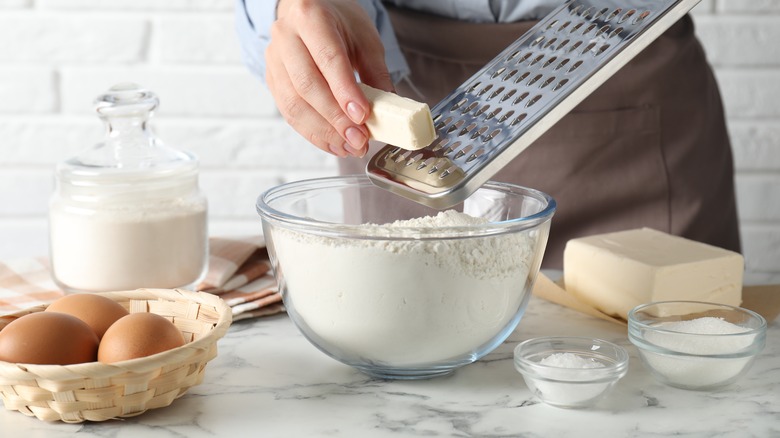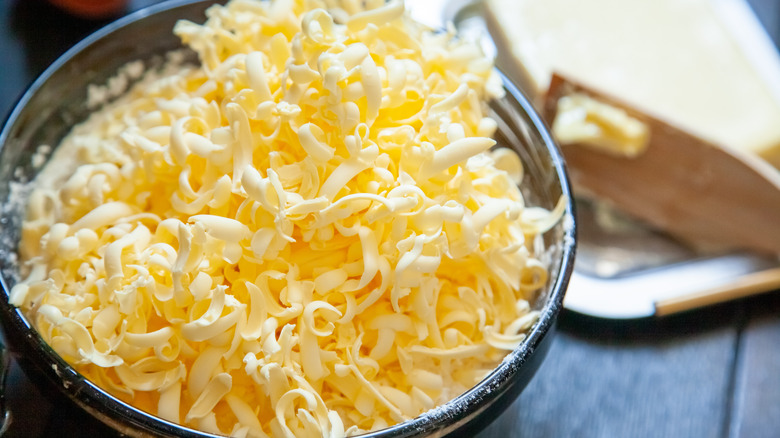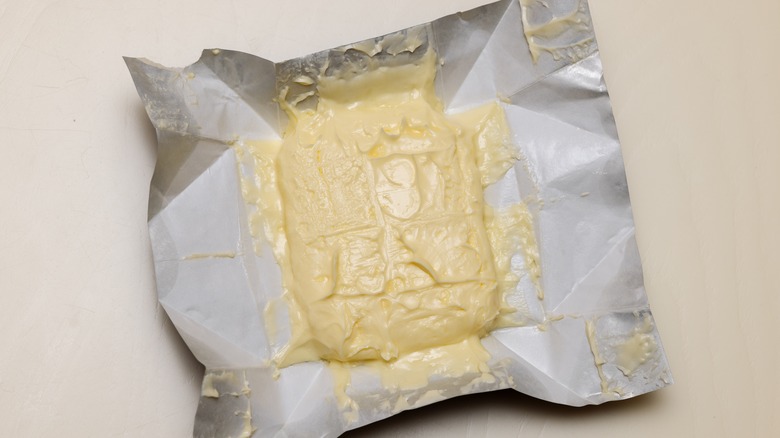The Unexpected Kitchen Tool That Softens Butter With Ease
Suddenly realizing that a recipe you're preparing calls for a stick of softened butter can leave any home cook in a scramble. After all, it can take hours for a butter stick right from the fridge (longer from the freezer) to transform into a spreadable, softened consistency when it's left on the kitchen counter. Instead of microwaving it, which runs the risk of quickly melting the butter, try breaking the butter up into small, thin pieces by way of a cheese grater.
Rock-solid though it may be, a cold stick of butter is no match for a cheese grater. Simply grate the whole stick into a bowl or on a piece of parchment paper. Now, instead of waiting for an entire block of butter to soften, those teeny tiny pieces will soften up swiftly, and in no time at all, they'll be ready to incorporate into your cake batter, cookie dough, frostings, and brioche loaves.
Many types of cheese graters will do the job, from flat graters to rotary ones (like the ones Olive Garden uses), but box graters might be the most comfortable and stable, plus they contain all of your grated butter in the middle until you remove the grater. If you need lots of softened butter, you can even use the grating plate on your food processor.
You may use this method more often than you think
Soft cookie dough and fluffy buttercream icing may be what comes to mind when you consider the times you need to grate your cold butter in a box grater, but you might be surprised at how often this method could come in handy. Few things are more frustrating than trying to spread a cold pat of butter onto a piece of bread for grilled cheese sandwiches, or even on a slice of toast. The tiny, grated pieces will quickly soften and spread without tearing up your bread, and the heat of fresh toast will start to melt the butter right away. The same concept applies to warm pancakes and waffles: just grate some butter over the top instead of spreading chunks of it with a knife.
Grate butter on top of your roasting turkey and chickens, shower it over veggies that are roasting in the oven, put it right on top of rice and the best mashed potatoes. As for baking, grated butter is perfect for incorporating into pie, biscuit, and scone dough. Instead of breaking down chunks of butter into your flour, the butter is already finely processed, so you can simply stir the two ingredients together with some ice water for your dough to form. And there is nothing easier than using grated butter to make "rough puff" pastry.
Other ways to soften butter
Grating firm, cold butter on a cheese grater certainly isn't the only way to soften your sticks in a jiffy. Other popular methods include filling a glass or ceramic bowl with very hot water, then pouring it out and using it to cover your sticks of butter. The residual heat from the bowl is supposed to create a warm environment that the butter softens up in without melting it. Using a vegetable peeler to shave thin pieces of butter will give you butter that's easy to spread, but this is probably best when you just need a bit for toast and breads, not when you need to soften the entire stick. Cutting butter up into small chunks will also speed up the process of bringing it to room temperature, but it won't happen as fast as it does when you grate it.
Of course, there's the old microwave that's naturally designed to raise the temperature of whatever is put in it, including butter. The problem with using the microwave is that you really need to watch the butter like a hawk, and heat it in short increments. If you don't it could quickly melt, and melted butter is no substitute for softened butter because it can completely change the consistency of your recipe. Although unconventional, beating your firm butter with a rolling pin is another fast way to soften it up, and is arguably the most satisfying.


